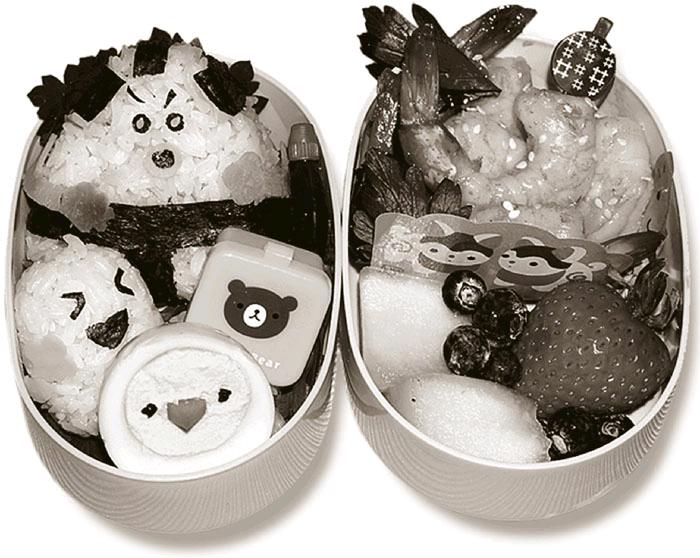备受争议的“便当史”
By+Stephanie+Buck
Its not another middle class DIY project. The bento box is a staple of Japanese culinary history.2
The history of bento is far deeper than Pokémon cafés and Pinspiration.3 The Japanese lunch container evolved from utility to status symbol to kawaii over the past 15 centuries.4 In fact, during times of economic uncertainty owning a bento box was downright5 controversial.
In the 5th century, Japans farmers, hunters, and warriors packed their lunches in sacks or boxes and brought them to the fields.6 The design is derived from a farmers seed box, and usually features multiple compartments7 for different dishes, such as rice, vegetables, and fish.
From there, bento spread across countries—China, South Korea, the Philippines, and more. The word“bento” was actually derived from the Southern Song Dynasty slang8 term biàndāng, which means“convenient.” Each culture adopted its own dishes for the box, but the idea of a varied, balanced lunch remained constant.9 Bento became a favorite for cultural gatherings and social events, such as festivals, theater, and religious holidays. Boxes themselves could be made of lacquered10 wood or basket material. When the aluminum bento became popular during Japans Taishōperiod beginning in 1912,11 bento suddenly went from lunch to luxury.
After World War I, Japan grappled with12 economic inequality. While its newfound hegemony in Asia grew Japans industry, farmers and more traditional laborers contended with unstable crops.13 The wealth gap trickled down14 to Japans children. Wealthy parents sent their kids to school with shiny bento lunches, neatly packed with nutritious fare15; poor families could no longer afford the once-simple bento.
“My mother was older than the other kids mothers and she filled my lunch box with tiny, traditional porcelain16 dishes and cups. The other kids had modern lunch boxes with jelly sandwiches and wieners cut to look like bunnies,”17 writes Gaku Homma in The Folk Art of Japanese Country Cooking. His mother was relieved when the school lunch program began.
Initiated in the late 19th Century, the Ministry of Education recommended nutritious meals for all schoolchildren. The school lunch later became standard18 in 1954, during World War II reconstruction. Homma remembers those lunches typically contained a cup of milk, koppepan (a loaf of bread), a pat of butter,19 rice, and a bowl of soup. Each kid brought a large cloth napkin to eat on. (The napkins also became status symbols, just as bento had, stitched on new sewing machines with tulip or butterfly designs.)20
Bentos popularity resurged21 in the 1980s along with TV dinners and other “convenience”dishes. By this time, the US and other Western nations had already been introduced to bentos charm. Japanese-American sugar plantation22 workers were the first to bring the bento lunch to the US.
In the 1990s, character bentos (kyaraben) were born and are still incredibly popular today, with fantastic, edible creations that are as delightful to Instagram as they are delicious to eat.23 Besides Pinterest, parenting magazines and back-to-school blogs the world over have featured24 bento recipes, ideas for shaping rice balls into baby pandas for kids lunches.
In fact, the bento box has merged with a core element of some Japanese art, which prizes not just a works outcome but the process itself, which should be intentional and precise, a craft honed over years of study.25 The philosophy manifests in everything from calligraphy to umami to plastic food.26
Its not uncommon for some mothers to spend up to 45 minutes per childs lunch, according to Christopher D. Salyers, author of Face Food: the Visual Creativity of Japanese Bento Boxes. Again the bento meal has become a marker for social status, with the most popular children unboxing27 the most elaborate bento.
In Japan, bento is served virtually everywhere, from Sailor Moon cafés to train-station food carts.28 And the original intention—a quick, portable, nutritious lunch—still holds strong.29
1. controversial: 引起爭论的;bento box: 便当,便当盒。
2. staple: 必需品,常备物;culinary: 烹饪的。
3. Pokémon café: 精灵宝可梦主题咖啡馆,Pokémon是日本最有名的游戏、漫画和动画之一,多译作《精灵宝可梦》、《口袋妖怪》、《宠物小精灵》、《神奇宝贝》等;Pinspiration: 一家DIY手工制作坊,其灵感源于创意展示、图片分享平台Pinterest。
4. 在过去的150年中,日本的食盒从实用价值上升为地位象征,直至如今的卡哇伊文化。kawaii: 日本可爱文化,中文常音译为卡哇伊。
5. downright: 彻头彻尾地,完全地。
6. warrior: 武士;sack:(装食品等用的)厚纸袋;field: 工作的场所,对于warriors来说指战场(= battlefield)。
7. compartment: 格,分隔间。
8. slang: 俚语。
9. 每种文化的食盒都有自己特定的菜式,但始终奉行一个理念,即食材丰富和营养均衡。constant: 始终如一的。
10. lacquered: 喷漆的。
11. aluminum: 铝制的;Taishō period: 日本大正天皇时期,约为1912至1926年。
12. grapple with: 尽力解决。
13. hegemony: 霸权,领导权;contend with: 对付,与……斗争;crop: 收成。
14. trickle down: 逐渐影响,缓慢影响。
15. fare: 饭菜,饮食。
16. porcelain: 瓷制的。
17. jelly sandwich: 果酱三明治;wiener: 维也纳小香肠。
18. standard: 普遍的。
19. a loaf of: 一条,一块;a pat of: 一小块(黄油)。
20. stitch: 缝;sewing machine: 缝纫机。
21. resurge: 复兴,再起。
22. plantation: 种植园。
23. kyaraben: 又作charaben,是character bento的缩写,指把食物做成可爱的卡通人物、动植物等形状的便当;edible: 可食用的。
24. feature: 以……为特色。
25. 实际上,便当融合了一些日本艺术的核心元素,它看重的不只是作品成果,而是制作过程本身,这需要精心构思和精细制作,体现的是十年磨一剑的技艺。prize: v. 珍视,重视;intentional: 有意的,有心的;hone: 磨炼,训练。
26. manifest: 显现,体现;calligraphy: 书法;umami: 鲜味,甘味;plastic: 可塑的,这里是指像便当这种手工精心制作的。
27. unbox: 拆盒,拆箱。
28. Sailor Moon café: 美少女战士主题咖啡馆;cart:(用于送食品和饮料的)手推车。
29. 提供一份快速、便携和营养的午餐,这些作为便当的初衷依然不可动摇。portable:便携的。

